Notes from the Platform's Edge

1. In recent weeks I’ve gotten a handful of notes from people letting me know that something or other is up with websites they work at or run. “You have probably heard this from everyone, but everyone within Hearst is FREAKING OUT because something happened in FB in last three months where traffic is tanking,” said one. I’ve heard similar things about some, but not all, properties at Conde Nast, which, hmm, just acquired Pitchfork? Congratulations! A number of sites at Gawker Media have fallen off; last week, Gawker.com Editor in Chief John Cook wrote in a memo to employees: “Traffic is flat.” He attributed this, partially, to underperforming writers. At small, less-diversified sites, which were aware and worried about this possibility, and at large, and extremely diversified new media companies, which were aware of and nominally betting on this possibility, the story is similar: referrals from social sites either plateaued or slowed earlier this year, and now they’re falling. Some absolutely, some relative to post volume. On Facebook, a link is worth relatively less than a photo or a video. In theory, it’s also worth less than an Instant Article, but those are still “rolling out” (lol) due to what is apparently a messy and difficult implementation. Regarding Instant Articles, the latest line from Facebook to publishers is “you’ll hear from us first when we’re ready to ramp up.” Regarding traffic woes, some publishers have been told to expect an update this week or “soon.”
2. Anyway, on the Extremely Very Millennial front, a pair of charts. Here is Thought Catalog’s Quantcast chart.
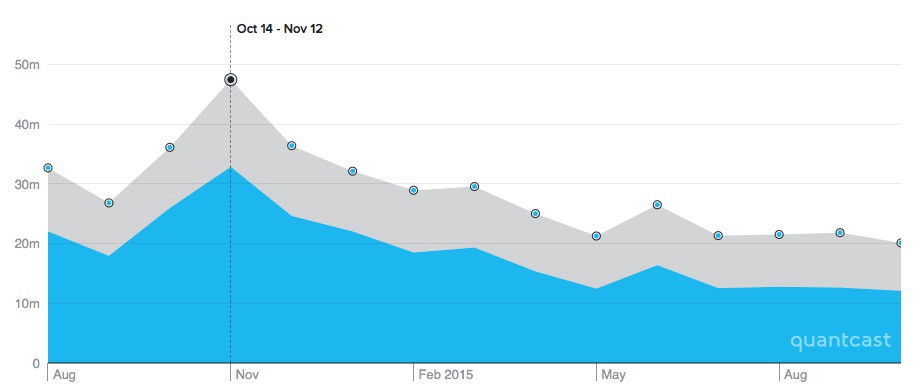
Quantcast grain of salt, etc. But the direction! And here is the chart for Elite Daily:
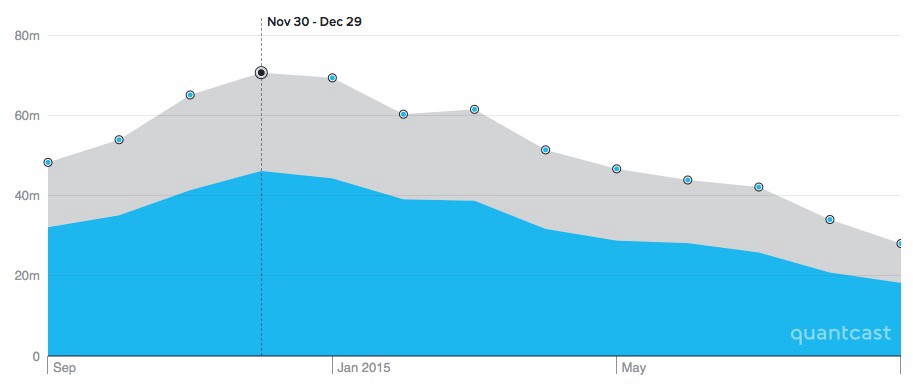
Elite Daily was acquired by The Daily Mail in… [Googles for a few seconds] oh, haha, January.
3. The data that would tell this story most neatly would have to come from Facebook. We could ask how much sharing is happening in general; we could separate out that data into types of media; we could determine not only what proportion of a typical user’s shared posts include links to websites, but how much of their attention is dedicated to links from others. We don’t have that data. But we have slivers. Here are the most-shared publications on Facebook for June, July and August, according to Newswhip:
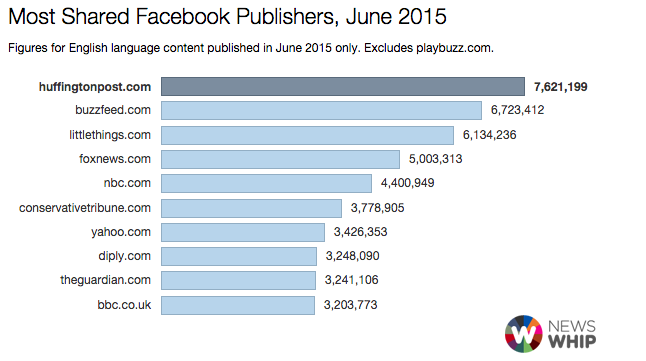
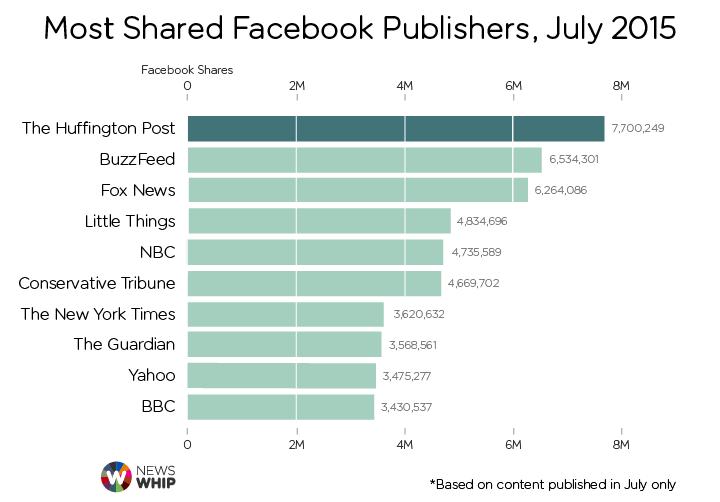
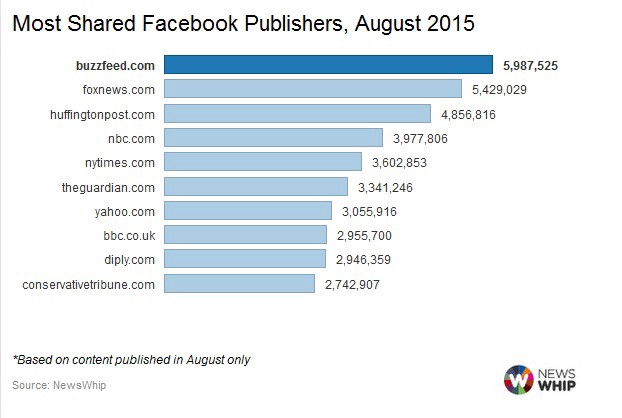
There are a number of stories here aside from the straight rankings. Consider total shares for the Huffington Post each month: 7.6, 7.7, then 4.9 million. Or for BuzzFeed, which is currently on top: 6.7, 6.5 then 5.9 million. Or for Fox News, which seemed to be enjoying an election season bump that has since been mitigated: 5, 6.2, and 5.4 million. Little Things, an extraordinarily deliberate and effective viral web project, disappeared off the chart; PlayBuzz is no longer listed, at their request. But the weirder story is the total shares among the top ten each month. June: 46,781,336 shares between the top ten. July: 48,833,666. August: 38,896,157. This is slightly lower than the most recent trough, in December. It’s worth keeping in mind that, since then, many publishers have heaved resources into Facebook video, which will likely account for a great number of these remaining shares. We’ll have to wait a week or so to see the September numbers. Should be interesting!

4. One week after Twitter launched Moments, which is an attempt to create a deliberate editorial space inside the Twitter app, Snapchat decided to drop the Snap Channel, where it posted original video and text and image content alongside — and in competition with — its various Discover partners. Discover, like Moments, was a completely new space created within a very popular app. Unlike Moments, however, Discover does not draw from, or meaningfully interact with, Snapchat the network — it’s just an extra screen with a list of brands within which you can find editorial content and some ads, which you can screenshot and share if you want. As a standalone app it would not succeed in its current form; as a pulsing icon placed inside one of the world’s most popular apps, who knows. A whole lot of people are looking at it! Publications are still figuring out what to put inside it. Snapchat was trying to figure this out as well, and seemed to have settled on video produced by TV professionals before ceding the space back to its partners and laying those people off. Meanwhile, elsewhere in the app, Snapchat Stories, which are curated from various user posts, continue to make plenty of sense both as something you might watch and as something you might want to pay to inject with an ad. What makes those compelling is less a full engagement with the Snapchat network, such that it exists, than scarcity. There’s no other way to see strangers’ snaps, really! Twitter is public by default and people have been aggregating it to hell for years; Snapchat is by default a much more private service, so Stories feel like something you’re being allowed, not asked, to watch.
5. Twitter’s new editorial space was deliberately created but is being less deliberately filled: Its own staff creates some of the tweet collections while partners create others. Everyone is very clearly still trying to figure out what works: Tweetstorms? Slideshows? Simple aggregations around events? Hashtag games? These experiments follow from the formal restrictions of Moments, which I imagine Twitter will gradually loosen or at least change. Partners are beginning to experiment with content created specifically for Moments, which, if it succeeds, will gradually shape what Moments is in a way that makes it less like the platform it is attached to. If it turns out that more direct aggregations of Tweets — simple best-of style posts — are the Moments that people enjoy most, or live events and video recaps (let’s see how this debate goes!), then Moments will probably focus mostly on that, and track closer to the feeds as they exist already, becoming a place to pick events to temporarily show up in your timeline rather than something that demands to be checked. As Snapchat did, Twitter has left open the question of who will control this new space: Will Twitter just make everything itself? Will it let partners do it on their behalf? Both of these possibilities are left open, now, as are much more severe ones. Are you enjoying Moments yet? Would you look at it if it weren’t sitting in the middle of your app with an unread indicator? Twitter would very much like to know, and can probably already tell.

6. Facebook has so far been more cautious about tacking editorial products onto its platform. Trending Topics, though overseen and written by humans, gives off a distinctly algorithmic smell. Signal, an app to track and search what’s trending beyond the main topics, reaches Facebook users only through reporters. Instant Articles are a functional change to users’ feeds, not their interaction with Facebook as a set of screens and prompts and buttons. With Paper, Facebook released a sort of content-first version of itself: A newsreader that separated news into fairly traditional categories, much like Moments does. The problem was that the most compelling “section” was always the one created from links in your News Feed. The news categories seemed flat in comparison. Even the stories within them felt a little out of place, being as they were tailored by their creators for success within News Feed.
7. Facebook is, however, currently experimenting with a new editorial space. It is testing, with limited partners, an app called Notify, which lets people aggregate… notifications? It was previously reported by Business Insider to be “a standalone mobile news publication.” Now, a source shows us that it looks like this:
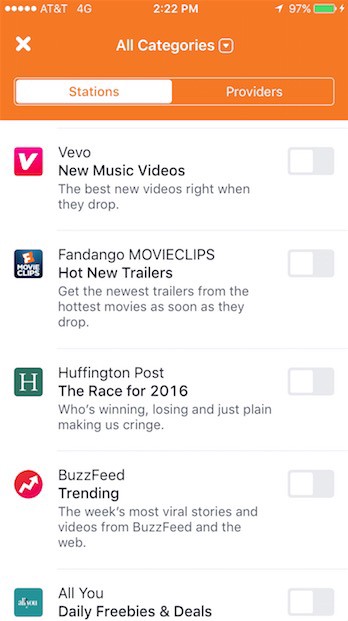
And performs like this:
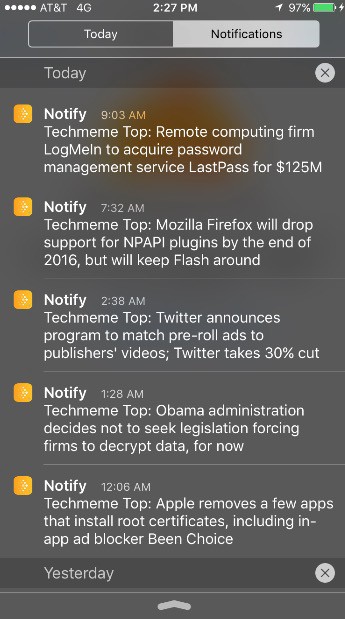
8. A successful Notify app, or, maybe, a notification pass-through for the Facebook app itself, which would let users select publications or people or, in their language, “stations” and “substations” to follow, would represent the creation of another sort of space: one that was previously inhabited only by Facebook’s own notifications, but which exists within Apple and Google’s notification interfaces. People are conditioned to get notifications from Facebook, which sends billions a day, as well as from news organizations — the Times app’s notifications are considered a hugely important part of the company’s digital operation. Anyway, this app is apparently launching at the end of the month, or somewhere around there? A bunch of publications are testing it out and getting assertive feedback from Facebook about post frequency, type, etc.
9. Apple and Google are both in the middle of big re-thinks about how people are supposed to look at stuff, what apps are for, how they should work, etc: The Apple watch is in one sense basically a notifications machine; both Apple and Google are trying, in newer versions of their OSes, to present bits and pieces of apps’ core functions outside of their respective app interfaces. They are, in other words, inserting new spaces into their platforms, too. (The new Siri has links to news inside it, even! Google Now shows you things it thinks you might like to read, based on things you’ve read.) An Apple Watch future or a Siri future or a notifications-based future would threaten the most obvious ways Facebook and Twitter make money — by cramming ads into feeds — so it makes sense, probably, to at least try to get ahead of it, by becoming a sort of news notification clearinghouse — better or more vital than the notifications sent to users by, say, an Apple or Google News app. So get ready for some buzzing, I guess!
10. Platforms’ early attempts to create editorial spaces are, taken together, at once completely understandable and totally incomprehensible. It’s understandable in that of course a company presiding over a platform of hundreds of millions of people and looking, either deliberately or more desperately, for new places to put ads, would think, hey, let’s bolt a new content and revenue apparatus onto this thing, to capture some of this heat (it’s what all the search and email portals did, too, because why not???). It’s incomprehensible in that, unlike feeds and friend networks, which are intentionally constructed in a way that’s obvious to both a reader and a poster, they don’t have to earn their audiences and therefore don’t know who or what they’re for.
11. What is the sensibility of Twitter Moments? Of Snapchat Discover, or Stories? Of whatever Notify will become? Moments and Discover sit next to their respective networks within the apps, and have generalist editorial staffs either implicitly or explicitly dedicated to vague notions of neutrality; Notify sits next to its network within the operating system, and seems to have no current editorial component beyond exhortations to post consistently (but not too much!). These separations demand new editorial choices from both the user and the platform: who or what to follow or look at, again, or what to shovel into these new empty spaces. Perhaps more important than any editorial “sensibility” is that these space leave behind their platforms’ core ideologies, which are of course all about self-perpetuation. Facebook’s ideology follows from a desire and design for more engagement, always — this is animated and embodied by its network and its feed. Twitter’s does as well, perhaps less effectively. The content that has worked best on both has bent to and exploited this ideology by understanding how it moves in relation to the users’ identities, against which every share or read is contextualized. It is not at all clear where these new editorial spaces belong, exactly, or how they’ll interact with the strange attention economies that led to their creation; it is interesting, certainly, how cautiously they engage with user identity. Though I guess how would they!! Speaking of economies, what’s even the metaphor here. Are these publication-like things tax shelters? Multinationals? Agencies of the state? I guess who cares? We’ll sort that out in retrospect!

12. From the margins of the platform, the transfer of attention from publications to platforms, and the platforms’ sudden desire to do something with this attention — out of a sense of responsibility? opportunity? not need, yet, but a prediction of need? — seems especially perverse. From a more central vantage — say, a company that’s partnering with every platform at once, with broader ambitions to Create All The Content, the concerns are probably more immediate: What do these platforms want from us? What will they then want for themselves? What will be left for the partners? If the platform is asking questions about content, they’re a level closer to the metal: What are we supposed to do with text? What about video? Where do these things go, and what shape should they take? These concerns overlap mostly by coincidence.
13. Publications large and small but especially large spent the last few years in a sort of para-economy, watching their audiences and sometimes revenues explode as the result of informal partnerships with social platforms, which were happy to let these outsiders hustle to adapt all manner of writing and imagery and video to their new contexts. The self-pitying/aggrandizing explanation for the platforms’ annexation of media attention would be that the last few years represent a sort of free-booting period during which media gave Facebook no-strings content in exchange for attention, which was converted into revenue in a system of advertising Facebook was simultaneously intent on destroying.
14. I’m thinking more and more that the various narratives about social media and The News, ours included, have overemphasized the role and responsibility of the media in terms of the content it produces and the role that content purports to play in the world. All along, platforms and publications have been interacting in two ways: on one end, by mingling audience and attention; on the other, by the advertising business model of one replacing the advertising business model of the other. Platforms are where the internet advertising money is going as it leaves the part of the web that supported online publications. Web advertising is getting replaced with something more effective! These new in-house editorial projects located at the center of the platform, rather than at its edges, will succeed or fail based on how they assist in that project — not according to how well they replicate or replace or improve on publications supported by a model they’re in the process of destroying. Publications-like features, or channel-like spaces, just happen to be the only place anyone on either side knows where to start.
Bruce Brubaker, "Mad Rush (Julian Earle Remix)"
For my money the greatest remix project involving the work of Philip Glass remains dj BC’s Glassbreaks — particularly the Q-Tip/Dance 5 mash-up — but this collection of work based on Bruce Brubaker’s fine recent selection of Glass piano pieces (the unimaginatively titled Glass Piano) is pretty good too, if that’s the kind of thing you’re into. Enjoy.
The Robustitude of 'Robust'
by John Patrick Leary

“Tender and Delicate Persons have so many Things to trouble them,” wrote Francis Bacon in 1625, “which more Robust Natures have little Sense of.” Two centuries later, when the New York City minister Thomas de Witt Talmage visited Boston, he was impressed by its people’s robuster natures. “When a mutton chop is swallowed of a Bostonian it gives up,” he wrote in Around the Tea Table, “knowing that there is no need of fighting against such inexorable digestion.” For the women of Boston, it is no longer fashionable to be “delicate.” Instead, Talmage observed, “they are robust in mind and always ready for an argument.”
“Robust” is not often used this way today, to describe bodies and constitutions: now, it is most common as an economic term, almost always accompanied by “growth” or “economy,” or as a way of marketing olive oil, coffee, wine, and tea. It’s a standby in the “creative-class” argot in which “innovation” is the greatest of all virtues. Consider the precious gentrifiers of Philadelphia’s Edward Bok Vocational School, who are building a craft-beer bar and incubator for “Do-It-Yourself (DIY) innovators, artists and entrepreneurs” in a South Philly public school recently shuttered by state budget cuts to the city school district. Bok is a “robust” structure, built to last — or so the WPA workers who built must have thought. Now its sturdy joists and hardwood floors will support “a critical mass of creatives,” which must weigh a lot.
Its overuse in the press and by technology workers has been parodied by a newly coined noun formation, “robustitude” (although some in the tech sector use “robustitude” perfectly earnestly). Penn State’s English department, perhaps anxious that students and parents see a literature degree as professionally weak, describes its curriculum as “robust.” It is a popular political term of art, to describe the “robust debate” that politicians say they welcome, especially when they don’t. For example: when Barack Obama ways he hopes to have a “robust debate” on his Iran policy with Republican rivals, clearly he’d rather not. When Wisconsin Governor Scott Walker signed a law gutting the state government’s open records law, allowing legislators to work in secret, he claimed that the move would promote “robust debate with state agencies and public employees over the merit of policies,” which was obviously the opposite of what it was meant to do.

New York Times, June 16, 1900
In the 19th century (and the first half of the 20th) “robust’s” collocates — the words appearing most often alongside it — were “constitution,” “vigorous,” “ruddy,” “healthy,” and “manly.” “Only robust teachers for Chicago,” declared a New York Times story pinpointing teachers’ “physical weakness” as the public schools’ biggest flaw. “Robust growth,” meanwhile, was a phrase still favored mostly by seed catalogs selling hardy flower bulbs. Imperial British soldiers were often described as “stout and robust,” and military service would make a man out of nearly anyone, even on the losing side. Carlton McCarthy, in his memoir Detailed Minutiae of Soldier Life in the Army of Northern Virginia, 1861–1865 — strong title, Carlton — wrote that the experience of Confederate soldiering was fortifying, even in defeat. “Many a weak, puny boy was returned to his parents a robust, healthy, manly man,” he recalled.
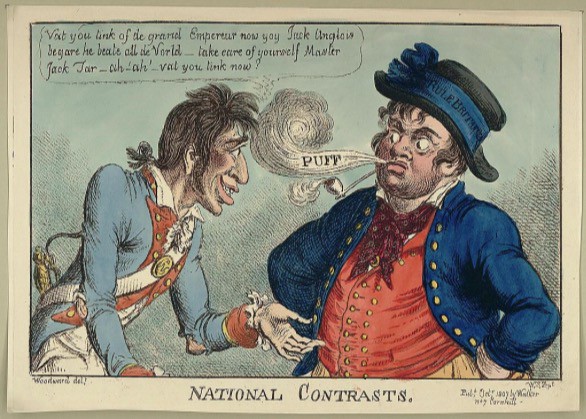
“National Contrasts” (published in London, 1807): A robust Jack Tar blows smoke in the face of a ragged Frenchman in Napoleon’s Army
“Robust” began to be associated with national economies, rather than individual bodies, after World War II; this usage surged in the 1980s, and reached its current popularity in the late 1990s. Ronald Reagan’s economic advisors were fond of the term, invoking it with regularity as the 1982 and 1983 budgets were released amidst a recession.
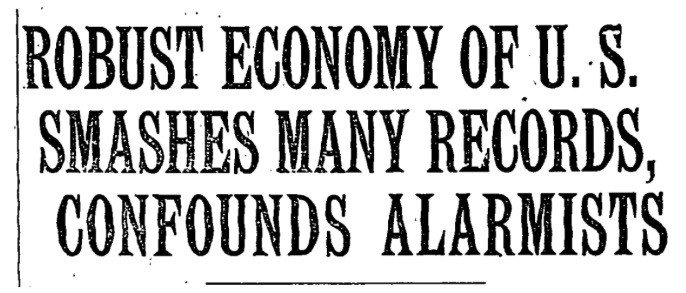
New York Times, January 4, 1954
Its usage for the U.S. economy seems to track with such moments of economic crisis or uncertainty. Writing of Ronald Reagan’s 1982 budget, US News and World Report wrote that “the President’s advisers predict that a brisk snapback from the recession, beginning in the spring, will launch the economy on several years of robust, uninterrupted growth.” And it is used this way today, as any search of the newspaper or Twitter will show: “Is the US economy sufficiently robust to begin the return to normality?” asks the BBC. “What the US can’t live without is robust economic growth,” said David Axelrod on ABC News in 2010. Or, as @VetsWivesForTrump declares, “We must grow the world’s strongest, most robust economy and cut spending in order to reduce the national debt.” Indeed, its old roots in militarism help explain its popularity among nativists like @VetsWivesForTrump and the popular British neofascist blogger David Vance, who tweets that “if all EU countries followed the robust approach of Hungary, the hordes of Invaders might think twice before seeking to impose themselves.” To stop ISIS, opined a Fox News host, we need a “more robust, manly version of Christianity.”

Wall Street Journal, February 8, 1982
The virile connections endure even for those off the racist right. A robust economy is also often also a “healthy” one. These metaphors treat the economy as a body — a fit, stout paterfamilias that provides for all the nation’s children. Robust growth is equally shared, in the way that a expanding balloon, or Pop’s vigorous pot belly, gets fattest around the middle. Hence the adjective’s common association with “buoyed,” as in “buoyed by robust growth”: the United States would flounder but for its stout, buoyant chum, the economy. The masculine “robust” metaphor raises the question of the gender pay gap, but direct uses of “robust” in connection to women’s wages are comparatively rare. One of the few is a 2014 White House Press release on “the Importance of Ensuring a Robust Tipped Minimum Wage.” Is a “robust” economy necessarily so for women workers? Such questions — of equality, rather than sheer size — may be too delicate for our modern “robustitude” to swallow.
It’s no accident that economic “robustitude” has risen alongside the rise of “lean,” “nimble,” and “agile” as economic buzzwords. Nimble firms require fewer workers, working more, in the service of “growth.” The robust economy is a beast whose inexorable digestion must be fed, preferably by the choice cuts laid off from a nimble, lean corporation. The robust monster is never full.
Moved Or Died?
Do you play “Moved or Died?” You know, the little game you have with yourself when you suddenly realize it has been a long time since you’ve seen someone you are used to noticing in your daily routine? You’ve never said a word to this person, or if you have not much more than “Good morning,” but they are as much a part of the scenery as the buildings and landmarks you pass by each day. When the moment comes where it occurs to you that you have not observed that person in quite some time, do you file them under “moved” or “died”? Do you try to imagine where or how? If you’re a happy person do you tend to imagine “moved” more often than “died”? So many questions! Anyway, it turns out that another possibility is “retired.”
Dan Friel, "Rattler"
Would your morning be improved by bouncing babies and shredding guitar? Uh, whose wouldn’t? ENJOY.
New York City, October 11, 2015

★★★★★ Vivifying cool air flowed over the ankles. Three food trucks and a cart were parked by the Apple Store. A block away was a delivery truck with a sunglasses store built into the back of it. Here was a shawl; there was a scarf. Just inside the Park, one oak was going to oranges and reds already. Rollerblades made a noise like a camera shutter and may have flashed, in peripheral vision, like a camera flash. A little girl jammed her fists into her cheeks at the sight of a horse waiting to be ridden. Out on Central Park West, the sun raised corpse-pale faces behind the tinted windows of a tour bus, looking out the side, in stadium seating running lengthwise. In the night, a star twinkled straight down over Fourth Street.
Jonathan Franzen Is Right
If the amount of time it took me to get through this article about Jonathan Franzen is any indication then he may actually have a point about how bad the Internet is. I mean, if that’s the thing he’s complaining about, how distraction-prone it makes us. I swear this tab must have sat open for two days while I kept flitting by and looking at other things. The actual lunch in question probably took less time to eat than it took me to read this. Hell, writing the whole thing up probably took less time than it took me to read this. And if Jonathan Franzen thinks the Internet is bad for some other reason than how distracting it is — let’s call the condition “tabstraction” — he is probably correct too, because the Internet is terrible and we all know it, it’s beyond dispute at this point. Fuck the Internet. It’s a trench filled with misery and despair and broken hopes and terrible GIFs. Hey, speaking of which, has anyone else had the thing happen where a picture loads and for a second you think it’s an animated GIF but really it’s just a static image? Like, it never moved at all? I swear this is a thing. Can some scientist out there explain what the hell is going on? For a minute you’re like, “Ugh, now this thing is going to wink at me for as long as I keep the tab open” but then it stops and it’s even worse because you feel a) slightly haunted, but by a GIF and b) like maybe you’re having a stroke? It’s terrible. Anyway, what were we talking about? Oh, right, Franzen. God, I know we’re all supposed to hate him and Lord knows he makes it easy (sometimes the only thing about him that causes me to find favor is the vehemence of his detractors), particularly when he’s all “blah blah blah birds my feelings the art of the novel” — Listen up, pal, you know what is admirable about Elena Ferrante apart from her writing? The way she mostly stays shut the fuck up about everything else! — but honestly, it’s hard to hate anyone who hates the Internet so much. What a titanic fucking disaster for everyone involved this whole shitbag thing turned out to be. Jonathan Franzen, you’re okay in my book. You keep hating the Internet and I promise that I won’t pretend to have an opinion on your actual work, which I bet is probably just fine if you’re the kind of person who likes made-up stories by some guy who has convictions about “literature.” Also, did you know that Google shows no results for “Hans and Franzen”? NO RESULTS? How could that be? Internet, you’re so fucking useless. Fuck you.
Dinner Old

What is your opinion on the ethics of eating animals? Hahaha, just kidding, I don’t care. Your opinion is unimportant and utterly incorrect. Whatever justifications you make to explain your choice to eat or to abstain are almost certainly inconsistent and in any event unnecessary. You yourself are of course an animal, buffeted about and baffled by forces you cannot understand, but also you are virtually indistinguishable from anything else to the cold indifference of the cosmos. There is no moral code that can wrestle sense from the vast nothingness that awaits your return and even nihilism itself is an empty response to a universe that neither knows nor cares how you choose to articulate its random assignments of existence. Be you eater or eaten you are the tiniest fleck of dust on a breeze that is unaware that it blows. The stories you tell yourself about the choices you make are of no matter (and are, on the subject of animals, if my own experiences of conversation are any indication, incredibly tiresome). That said, the big thing now in carnivority is eating geriatric cattle, so you can only imagine how exciting the debate is going to get moving forward.
Photo: Shutterstock.com
Y Kant Johnny Edit

Magazines, particularly the male-dominated magazines, which include basically all the magazines except the magazines devoted to women, serve their own purposes. They don’t particularly care about writers or their actually very segmented audiences, although at the same time they live in fear of a mythologized audience. Here Is Our Audience: He Lives In TriBeCa And Goes To Equinox And Isn’t Sure Where The Best Sushi In Soho Is Now. That he is actually only eight men and seven of those men don’t read magazines isn’t relevant. The male magazine audience member also lives in a perpetual state of divorce and horniness: he must be, all at once, 43 sex tips and best husband and hot dad and also on the prowl. Abs Man and Dad Bod alike! The Male Magazine itself, having passed on over through its emotional crisis, lives in a sad new bachelor apartment of the mind, in a conference room and on an email chain. The “general interest” (male) magazine editor is always waiting for his boss to come back from Milan and tear up all the work everyone has done in the last week. The magazine male has a reasonable fear of commitment to a way of writing a piece. The magazine male is often punished. In the world of the magazine by committee, no profile or essay can satisfy.
The magazine piece lives in a horrifying multiverse, where every possible version of the piece must be executed and then discarded, at least in part to score points in the office game of alphas versus betas. This is workplace hamstering, to borrow the gross and useful term of the mens’ rights universe. I think when men are involved they call that gerbiling but that sounds too anal for what we’re talking about. Office Hamstering is the demonstration of workiness. An editor must prove that he works many hours. It can be unconvincing that one is important if one is not constantly closing a piece. OH I AM SO BUSY! I am already having had worked, I will have worked, I have been and will be working! SO BUSY.
And then, so truly busy, when the committee stomps on in. Senior editors must hamster as well, and they will do it on your story.
The committee will always peg a writer’s essay to a movie that is about to come out and bomb, which was pretty obvious even a couple months ago.
The committee will always ask you to “run some things by the publicist.”
The committee will always “have some last-minute ideas.”
Sometimes, the committee will save you from making terrible mistakes.
You really can’t complain about editors too much without acknowledging that sometimes they literally save lives.
It’s sad that few printed magazines allow the convictions of their story editors.
But mostly, an assemblage of bonobos are pasting up a magazine together, each thinking about the position he will be in when the editor-in-chief finally retires or is auctioned off.
Magazines have become too petrified to give us what we want. They’re right to be afraid, because we want all of the things. We are terrible! But then, magazines are antisocial media. So every magazine choice becomes agonizing, every edit inching closer to an infinity.
Maybe we have driven magazines insane.
this photo is the only way tell if this profile is fiction or not tbh pic.twitter.com/Xpnfq1DZ1t
— LW (@lindseyweber) October 12, 2015
Sometimes, magazine stories become gates instead of windows. This even happens at magazines that employ women! The manufacture of the story creates a distance between us and the subject of the story. You can see why women pop stars prefer to produce and execute their own content, rather than playing with the media to let it be created from them. There, sometimes, a subject becomes obscured, instead of revealed. Maybe that’s on purpose sometimes? Maybe it’s a byproduct of the system, where this one iteration of the story was plucked from the windowsill of all time and space. In any event, this is why T magazine should release the transcript of their Rihanna interview that was used for the profile they have just published. It is her first extensive interview in years. No one needs the media less than Rihanna. And yet, they have two hours of Rihanna talking for a piece that in this universe includes almost as much quotation from the writer’s Uber driver as it does from Rihanna herself. Thank the heavens for all involved, this published iteration of the story remains illuminating, charming, funny, insightful. It is filled with lots of really good ideas. And yet. The public words of Rihanna, which are so few, and so impressive, should belong to us all. Those birds want to fly free. Who is a magazine to keep us from hearing from Rihanna?
